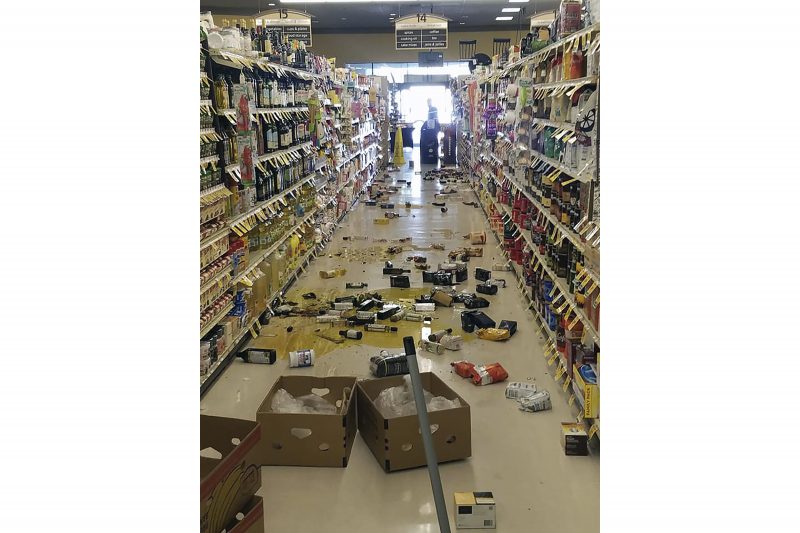Southern California rocked by strongest quake in two decades
This picture courtesy of Rex Emerson shows broken bottles and other goods in a store in Lake Isabella, California after a 6.4 magnitude quake hit Southern California on July 4, 2019 (HO)
Los Angeles (AFP) – Southern California was rocked by a 6.4-magnitude earthquake Thursday morning, the US Geological Survey said, with authorities warning that the temblor, the largest in two decades, might not be the day’s last.
The shallow quake struck in the vast desert region of the Searles Valley in San Bernardino County just six miles (10 kilometers) from the town of Ridgecrest at 10:33 a.m. (17:33 GMT), but was felt 160 miles away in Los Angeles and even as far as Las Vegas in the neighboring state of Nevada.
Local authorities emphasized that the end of the earthquake did not mean residents were yet in the clear, however President Donald Trump wrote on Twitter that “All seems to be very much under control!”
Caltech seismologist Lucy Jones told a press conference that residents “will continue having a lot of aftershocks,” adding that dozens had already occurred and that some may be as strong as magnitude five.
Emergency responders did not immediately report mass injuries or any deaths, but USGS seismologist Rob Graves said that “this earthquake is large enough that the shaking could have caused damage.”
The quake was the largest in Southern California since 1999 when the 7.1-magnitude Hector Mine quake struck the Twentynine Palms Marine Corps base, according to The Los Angeles Times.
The fire department in Kern County, which encompasses Ridgecrest, reported it was “working nearly 2 dozens incidents ranging from medical assistance to structure fires in and around the city” and that evacuations were underway at the Ridgecrest Regional Hospital.
The San Bernardino County Fire Department meanwhile said that “buildings and roads have sustained varying degrees of damage.”
This included “buildings with minor cracks; broken water mains; power lines down; rock slides on certain roads,” but no injuries or fires.
The quake struck at a depth of 5.4 miles (8.7 kilometers) in the vast desert region, lasting multiple seconds.
Its epicenter was located in or on the edge of the US Navy’s sprawling desert bomb testing range known as China Lake.
The Naval Air Weapons Station covers 1.1 million acres (445,000 hectares) and strictly controls the airspace above it. Inside, the Navy develops and tests missiles, bombs, artillery shells and other war ordnance, and the aircraft used to deliver it.
An official at China Lake said there was “substantial damage” to their facilities, including fires, water leaks and spills of hazardous materials.
Los Angeles International Airport said its runways were unharmed, with operations continuing as normal.
The city’s police, meanwhile, reported on Twitter that they had not “received any reports of damage or calls for service.”
– ‘Even bigger earthquake’ –
While California is the most populous state in the US, the quake was located in a sparsely populated portion of the Mojave Desert.
Jones said there is a small possibility this quake is the prelude for a larger tremor.
“There is about a one-in-20 chance that this location will be having an even bigger earthquake within the next few days, that we have not yet seen the biggest earthquake of the sequence,” she said.
Celebrities in Los Angeles were quick to react to the trembling.
“Been living in Los Angeles all my life,” filmmaker Ava DuVernay wrote on Twitter. “That was the longest earthquake I’ve ever experienced. Not jerky. Smooth and rolling. But it was loooong.”
Disclaimer: Validity of the above story is for 7 Days from original date of publishing. Source: AFP.


